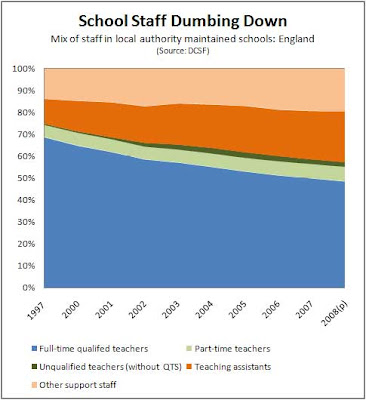Hard on the heels of last week's teachers' strike, we've had news of school pupils being paid to take lessons in place of qualified teachers:
"A school is paying sixth-formers as young as 16 to teach lessons instead of hiring qualified supply staff. It has put a team of 24 A-level students on standby to fill in when regular teachers are away, paying them £5 for each 50-minute lesson they take. The headmistress says they do a better job than qualified adult teachers hired from supply agencies."
Meanwhile, Schools Minister Jim Knight has released a Good News Bulletin. He says:
“Teaching is now one of the most sought after professions thanks to increases in the average teacher’s salary by 19% in real terms to an average of over £34,000; cuts bureaucracy and tougher disciplinary powers for staff. The result is almost 41,000 more teachers in our schools in the last decade and buoyant recruitment.”
Huh?
“There are now more teachers, teaching assistants and support staff and more staff per pupil than ever before. We’ve freed up teachers from administration tasks to do what they do best - teaching and giving pupils more individual attention. And we have invested massively in support staff on the ground to give them the back up they need."
Since every teacher we know is severely hacked off, and the pupils evidently do a better job than qualified teachers, we decided to take a closer look. Just what has been happening in the staff room? What do Knight's claims actually mean?
First, let's note that last year the government spent £41.5bn on schools in England. That's up from around £23bn in 1997-98, an increase of about 80%. Which is a lot of money.
So have teacher numbers increased by 41,000, as Kight claims?
Well, waddaya know, yes they have. According to the official stats, the number of full-time equivalent (fte) teachers increased from 400,000 in 1997 to 441,000 this year. So he's spot on.
Except, when you study the detail, a very large number of these extar teachers turn out to be unqualified and/or part-timers.
First, strip out the statistically shadowy 6,000 who work for the new Academies and City Technology Colleges- we know virtually nothing of their provenance. That leaves 435,000 working in the traditional local authority maintained school sector, up by 36,000 since 1997.
Of that 36,000, no fewer than 14,000 lack what's known as Qualified Teacher Status (QTS). In other words, they are teaching without the proper qualifications to do so. Back in 1997, the number of such teachers was a mere 3,000, so under Labour there has been more than a fourfold increase.
And of the 22,000 additional qualified teachers, 20,000 are part-timers: there are now over 100,000 part-time teachers altogether, and on average they work about half-time, thereby comprising 50,000 full-time equivalents. While they may be perfectly good teachers, we can't help thinking there are some obvious disadvantages in terms of teaching continuity.
Which means that the increase in traditional qualified full-time teachers - the sort of people we'd like teaching your children - actually comes down to a mere 1800. Or less than one-tenth of an extra teacher per school.
So much for Knight's trumpeted 41,000 extra teachers. But what about all those support staff he goes on about? They must help, right?
Well, since 1997, the number of support staff in state schools has exploded.
The number of classroom assistants has virtually trebled, going from 61,000 to 176,000. A trebling. They've gone from from one for every six full-time qualified teacher, to one for every two. It's a massive change in the way our schools are organised, and it's passed by virtually unremarked outside of education circles.
The number of other support staff has also rocketed, doubling from 73,000 in 1997, to 147,000 now.
The bottom line? Just as they've dumbed down our exam system, it seems Labour has also seriously dumbed down our school staff rooms. In fact, the proportion of school staff who are full-time qualified teachers has plummeted from 69% in 1997 to a mere 49% now: a 20% drop which means that fewer than half the people now employed in schools to educate our kids are full-time qualified teachers:
No wonder Chalfonts Community College has had to revert to the original Victorian method of pupil teachers.
Just one question: given they only cost five quid a lesson, when can we taxpayers have a refund on that 80% increase in schools spending?
